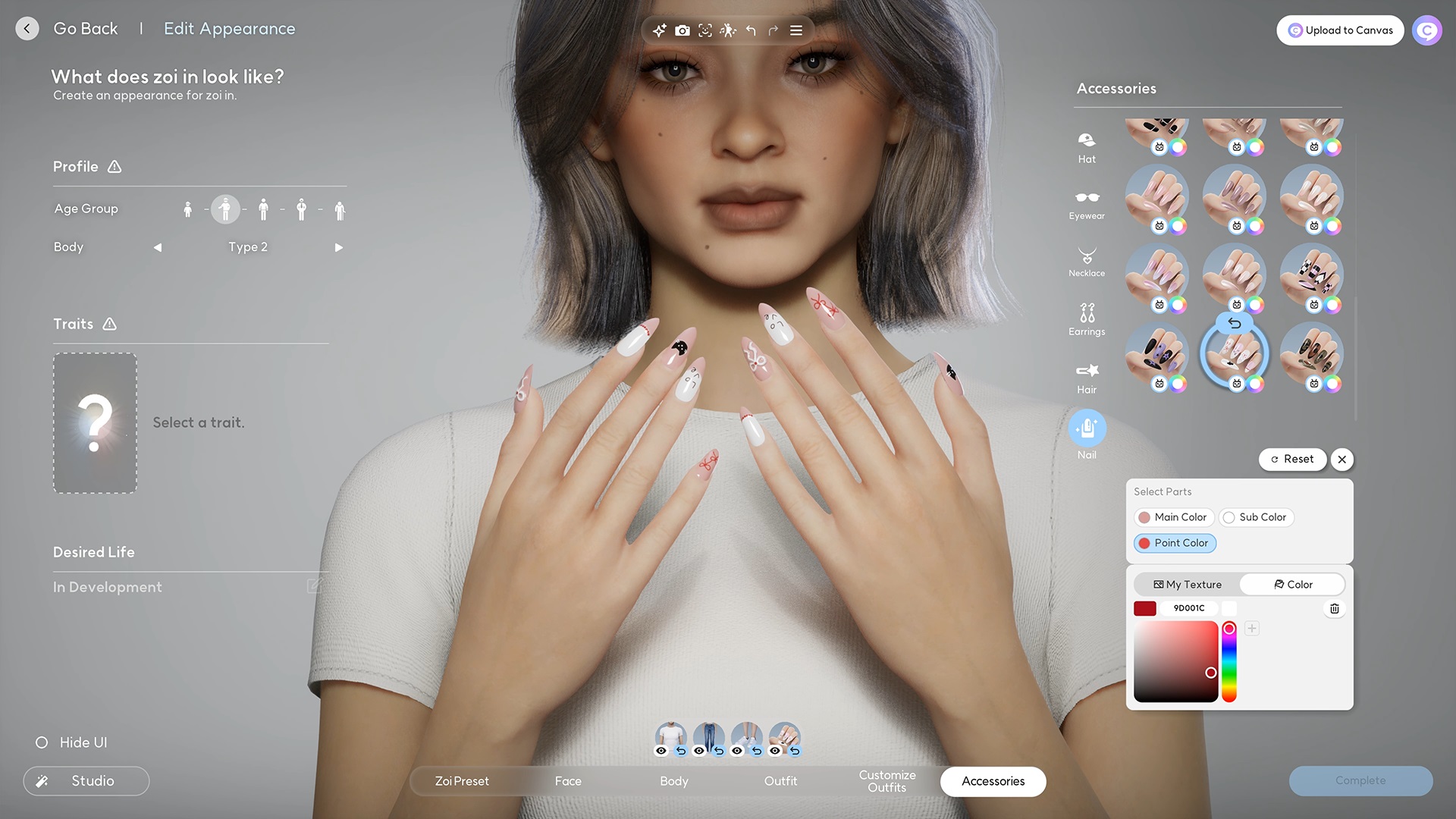In a briefing hall at this year’s Gamescom, Hyungjun Kim, producer and director of InZoi, took to the stage to share his vision for the future of life simulators. One slide, during a humbling section on the challenges encountered during development, showed a screenshot of a hyperrealistic infant levitating above his cot and scrolling on a smartphone with Slenderman fingers. The caption? “A cute, innocent baby does the unexpected.”

With the unfortunate cancellation of Paradox Interactive’s Life by You and no date in sight for EA’s Project Rene, there’s a clear gap in the market for a contemporary life simulator. Krafton hopes to fill this gap with InZoi, an everything-and-the-kitchen-sink Unreal Engine 5 Sims alternative, which is decidedly more stylish than its stylized counterpart.
In a booth where the upper body of a cat hovered over my head like a furry sword of Damocles, I started tinkering with InZoi’s stupendous character studio, which makes Black Desert Online look like Myst Online: Uru Live. I was quickly able to make a yassified approximation of myself, pulling at philtrums, yanking jowls, and highlighting partitions of mousy hair. For dedicated makers, the creative potential here is staggering, down to individual levers for chin cleft and hair edge softness, as well as color blending between the outer and inner iris.
InZoi takes an adaptive approach to clothing, too, with variable necklines and sleeve configurations available across parts of its impressive fashion-forward wardrobe of couture and streetwear. I decked out my Zoi in a Balenciaga-adjacent football jersey, as well as some dad shoes and baggy cargo pants. While modifying the color palette, I noticed an interesting wrinkle. You can upload your own textures and apply them to select pieces of clothing in InZoi, a clever feature that will motivate and benefit upstart designers.
You can also use InZoi’s built-in generative AI tools to summon textures for you, a decision I’m not so hot on. I gave it a go, of course, prompting a “1997 Windows screensaver” pattern and applying it to a button-up. The results were… fine, I guess, albeit tinged with the uncanny like most AI art. But I’d rather enjoy the process of learning how to make a texture in Photoshop for my Zoi or, failing that, just download another designer’s re-creation instead. Making a snapback covered in dodgy-looking hallucinated potatoes is probably fun for someone. Still, I can’t help but feel like the inclusion of generative AI just cheapens the appeal of InZoi, a game that otherwise has its finger on the cultural pulse.
Naturally, there’s an in-game browser for Zoi presets where you can upload your creations and download the efforts of InZoi’s creative player base. Some have already conjured meticulous re-creations of celebrities like Taylor Swift. Others have asked forbidden, definitely macabre, arguably Pandoran questions like “What would Wallace from Wallace and Gromit look like if he were a real-life guy?” (Fair warning — unless you want the Wensleydale eccentric’s bare feet seared into memory, I’d advise against that last link.) Of course, this cavalcade of tools also ends in a remarkable photo mode, where you can drop props into a custom studio and fine-tune the lighting. InZoi’s character creation suite is big enough to be its own game, honestly, but it’s the world beyond it that matters in the long run.
The narrative justification of InZoi is that you, the player, are an intern working for a company that makes and maintains Zois. They exist in little digital worlds on your desk that look a bit like O’Neill cylinders. From this perspective, you pick a plot for your custom Zoi family to inhabit, but you can also just zoom in and pick any of the world’s inhabitants to possess. I think it’s good to preface this to understand the scale of InZoi. It’s not just about making a character and living out their life — this is a sandbox world where you can really shake the snow globe. Players can drop crocodiles at the local park, affect the frequency of negative emotions en masse, drive around in real time, or build an apartment block in the middle of a street. InZoi’s nearest neighbor is obviously The Sims, but there’s also plenty of SimCity and even some Cities: Skylines DNA mixed in.
Each Zoi has an editable daily schedule, long-term ambitions, short-term desires, defining values, and traits that control their aptitude for certain activities. When my Zoi first arrived at their penthouse apartment, I flexed my interior design skills to renovate their bedroom with Inzoi’s powerful building kit and an Ikea’s worth of furniture options. Then I commanded them to rummage through drawers for clothes to donate, a unique action aligned with my Zoi’s coexistence value. In the menus, you can pick out preferences across categories like fitness or food, and your love of spicy food or yoga may crop up in conversation as a result. Regarding emotions, Zois have basic needs, but there’s also a series of states they can get into based on cumulative actions or reactions. A bus to the beach made my Zoi tranquil, but I was also enraged (I think I skipped breakfast), so I started fuming at a surfer as soon as I stepped on the sand. Handily, this introduced me to the conversation system in InZoi, which features separate trees of dialogue options depending on whether you want to get into business or bed with your interlocutor. Understandably, my first chat was colored by the white-hot rage my Zoi was experiencing — it went about as well as you might expect.
It soon became apparent that InZoi is a game of copious dynamic intersections, made better by being specific about who your avatar is and wants to be. The rub is that there are few consequences for changing your mind, situating InZoi in the trepidatious zone between game and simulation. Player agency and freedom come first, but does that all arrive at the cost of focus and, ultimately, your attention? With a button press, I could refresh my conversational options with seemingly infinite topical replacements. A wellspring of indecision inevitably complicated the promise of being able to do anything at any time. In practice, what lay before me was a deeply chaotic world full of procedural people acting impulsively. Zoi names, emotions, actions, and dialogue choices often felt random and divorced from context. As such, I didn’t get a sense of a functioning virtual society at play, unless it had descended into anarchy. I suppose you could argue that InZoi’s unpredictability is analogous to real life, but is that what makes a good life simulator?
Unfortunately, I didn’t make any memorable friends during my demo that I could tell watercooler anecdotes about. I befriended the aforementioned surfer by forcing him to come to my house for dinner, cooking him a meal (a wonderfully detailed process), and then quickly powering through the friendship conversation tree. But once he was sitting on my couch, still in his swim shorts, I wasn’t sure if I knew him any better than during our sunrise screaming match. Later, I couldn’t get anyone to talk to me for a meet-cute at the furniture store, so I played the claw machine outside for two hours, ate three tacos, and then built a bed in the street because I noticed my Zoi was tired. When I woke up, I told a lady in the park that “life’s best teacher is death.” A staggering amount of dialogue options are available for interacting with people you have never met, and the distance between estrangement and intimacy is only a few minutes of effort. So, why not surprise them with an existential crisis?
InZoi is a technical marvel, a mind-boggling, genre-eating life simulator that I’m keen to dig deeper into. But the moment-to-moment gameplay is still a bit rough around the edges. I was surprised by how much it left me longing for the quaint boundaries and quirky authored storytelling that are baked into The Sims. Oddball flourishes like the Goth family lore and the Grim Reaper constitute so much of that series’ soul. Perhaps we just need to wait for InZoi to present its answers to these issues, but given the outpouring of wishlists, I’m not sure it’s top of the list. Life simulation is an aspirational pursuit by design, and even if there are no plans to work in some storytelling and personality of its own, I’m hopeful that InZoi can stick the landing and deliver a profound gameplay experience to back up its awe-inspiring customization systems.
 Print
Print





